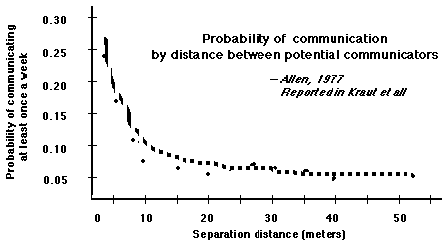Working In One Place or Many
by Jessica Lipnack and Jeffrey Stamps
The Seybold Series, #2 - July, 1989
Recently, a major transportation company faced a problem common
to many businesses. Simply stated, the issue is this: how to get
a major project done quickly and economically.
The company had decided to build a new CIM system that would vastly
streamline production. Because of increasing market competition,
time was of the essence; the project had to be done in record time.
In addition, the project was one of strategic importance.
Two camps quickly took opposite sides on how to best organize the
project for success. On one side was the senior executive who advocated
bringing together the hundreds of people the project required into
one building, and putting their noses to the grindstoneóa
co-located work group. On the other side, a group of project
managers argued for a network solution: find the best people for
the tasks required, leave them where they were, and hook them all
up electronicallyóa distributed work group.
Initially the issue was posed in rather stark either/or terms.
Either everyone had to be collected under one roof or everyone would
be scattered all over the globe.
The co-located model represents the conventional wisdom about how
to do high-pressure product development. The prevailing belief is
that if everyone is in the same place the level of collaboration
and communication will be high. Conversely, in the popular view
of the distributed model, people are perceived as physical isolates
staring at screens, removed from human contact and not communicating
with other people in any "normal" fashion.
We think this is a false dilemma for anything other than a very
small group. "One place or many," "co-located or
distributed," are false dichotomies in the real world of work.
To understand the issue, let's look first at some data that relate
physical proximity to collaboration and communication.

In looking at the probability of researchers collaborating as a
function of distance, a 1988 Bell Labs/University of Arizona study
shows what you might expect. People in nearby offices tend to collaborate
more than people farther away. What is surprising about the study
is how rapid and steep the dropoff rate is. Just moving from a common
corridor to elsewhere on the same floor reduces the collaboration
potential five-fold. And heaven help the manager or small company
that suddenly finds itself split between floors as the rate of "walking
around" and "water cooler" collaboration plummets.
According to the data, it would be better to be at a different site
than on a different floor!

This sharp dropoff in the effect of physical proximity is one more
confirmation of a general result reported by MIT researcher Tom
Allen in the late 1970s. Allen's study of engineers looked simply
at the probability of communication as a function of distance between
potential communicators. While the chance of talking to people who
work a few feet away is high, it plunges to less than 10% within
30 feet. After about 60 feet, it doesn't seem to matter how far
away a potential communicator is in terms of the likelihood of communicationóyou
might as well be in another country. And, if there is no communication,
there can be no interactions, no relationships, much less collaboration.
The conclusion is quite simple:
Only people in small groups can really colocate. Large groups
are by nature distributed.
Think of what it means to bring 400 or more people to one site.
Everyone cannot locate on the same corridoróa large group
is always spread out or stacked up to some extent. People can really
only be "close to" a few others. Work gets done in clusters.
People at all levels work in and go to meetings with others in small
groups.
While the "all-in-one-place" monolith is a myth, so is
the scatter-chart "everyone-is-alone" in a network a myth.
The truthóand the solutionólies in a mix of these
two views. When a company goes about identifying the 400 people
to be linked together into a new project, many will be recruited
as part of an already existing small group, or part of a new working
unit that is pulled together at a site with many other unrelated
activities. Individuals may, of course, be attached to a network
without functioning as part of a co-located small group. Distributed
work groups have both clustered and singular nodes.
Contrary to what many believe, people networks are not flat expanses
of organization one layer thick. They are multi-level and lumpy.
Although we tend to think of computer networks as horizontal webs,
they, too, seem to naturally develop in clusters. From the start,
large-scale wide-area networks have linked sites with smaller internal
networks, such as ARPANET in the early 1960s. Today, local-area
networks serve work groups and interconnect into departmental systems
that in the best cases are connected into enterprise-wide systems.
While the long first generation of mail systems sought to serve
captive audiences of one network, the new generation is quickly
moving to use gateways between networks.
People have worked in small groups for millions of years. Computers
can support this natural way of working, or, perhaps unintentionally,
fragment it. Online proximity is profoundly different from physical
proximity. For better or worse, online everyone can be an equally
short distance from everyone else.
So rather than slicing the issue into whether to co-locate or
network, we suggest a different set of considerations: What are
the major segments of the project? What functions need co-located
groups? How many sites are involved? How should they be tied together?
How do we combine technologies with face-to-face interactions?
Whether in one site or many, what we have in any large group is
a network of co-located small groups. Whether in one site or many,
any large group can benefit from network approaches to its work.
|